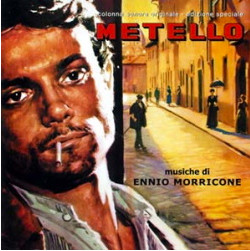主页--->m-comment-000--->mb-comment-010-96
|
电脑版 |
|||||||||||||||||||||||||||||||||||||||||
布罗克斯顿评说莫里康内 MB-010-96 |
||||||||||||||||||||||||||||||||||||||||||
FA6910 Metello / 我的青春 / 梅泰洛 |
||||||||||||||||||||||||||||||||||||||||||
作者 乔纳森·布罗克斯顿 (Jonathan Broxton) |
||||||||||||||||||||||||||||||||||||||||||
ENNIO MORRICONE 评论,第10部分 010-96 |
||||||||||||||||||||||||||||||||||||||||||
 |
||||||||||||||||||||||||||||||||||||||||||
梅泰洛 (1970) 《梅泰洛》是一部意大利历史剧情片,由毛罗·博洛尼尼执导,马西莫·拉涅利主演。这是一个男人如何努力摆脱导致父母过早去世的赤贫的故事——这种贫困定义了 19 世纪下半叶意大利北部的工人阶级。这部电影讲述了梅泰洛在意大利社会固有的阶级制度中奋斗,努力工作,但在与女性打交道时也利用他的美貌; 最终,他在工人运动中扮演了重要角色,但很快发现他必须平衡他新的和危险的政治活动与他积极的私人生活。 与许多莫里康内的作品一样,梅泰洛的配乐基于两个主要主题及其几种变体。主旋律“Metello”最初是一首优美、充满憧憬、亲密的旋律,在开场的“Tema Titoli”中,在原声吉他、木管乐器、小提琴独奏、钢琴、小号独奏和管风琴之间来回移动。然后,随着乐谱的进行,它经历了几种变化,包括一个值得注意的变化,其中旋律被安排为萨克斯管、长笛、cimbalom 和双簧管。这是一个可爱的主题,在一些文艺复兴时期式的和弦进行中可能有点过时,但它既说明了主角卑微的出身,也说明了他证明自己的愿望和愿望。最后一句话,在“Titoli Finale – Grande Orchestra”中,真的很棒,是专辑中最好的提示。 主要的次要主题是“Tema Scioperpo”——罢工主题——它更加沉闷和严肃,将木管乐器和 cimbalom 融合在一起,演奏出一种实际上感觉有点犹太音调的旋律,仿佛它在音乐的肩膀上承载着世界疲惫的重量。“Solenne Triste”变奏曲非常引人注目和戏剧性,钢琴和弦乐更加突出,而“Versione Lunga”则在其七分钟的长度中传递了众多不同独奏乐器之间的旋律。 还有一些一次性的提示,包括“L'Arrivo de Re”中华丽而黄铜色的富丽堂皇的 pastiche,“Pianino Nella Strada”中的一些老式源音乐,以及“La Naja”中小号、小提琴和鼓的生动军国主义乱舞。 Metello 不是 Ennio Morricone 最著名的配乐之一,但主旋律特别值得您寻找,就像您的浪漫主题以忧郁感为基础。这里回顾的版本是 GDM Music 于 2006 年发布的版本,经过数字重新制作和扩展,但与往常一样,有多种选择可供选择,包括 2014 年发布的 GDM 版本,它将乐谱与撒哈拉的秘密配对,作为 2 张 CD 套装的一部分。 曲目列表: 1. Metello (Tema Titoli) (2:44), 2.Tema Sciopero (Andante Triste) (1:58), 3.皮亚尼诺·内拉·斯特拉达 (2:15), 4.Metello (Tema Titoli Sax-Flauto-Cembalo-Oboe) (1:49), 5.Tema Sciopero (Solenne Triste) (2:04), 6.Metello (Tema Titoli) (2:19), 7.L'Arrivo del Re (Marcia Militare) (2:37), 8.Tema Sciopero (Versione Lunga) (6:57), 9.Metello (Ripresa) (2:58), 10.La Naja (Marcetta Per Tromba, Ottavino e Tamburo) (1:35), 11.Tema Sciopero (Ripresa) (5:57), 12.梅泰洛 (Ripresa #2) (4:04), 13.L'Arrivo del Re #2 (2:45), 14.Metello (Titoli Finale – Grande Orchestra) (2:39).GDM 音乐 GDM-2071,42 分 41 秒。 |
||||||||||||||||||||||||||||||||||||||||||
2021.2.13 |
||||||||||||||||||||||||||||||||||||||||||
|
| ||||||||||||||||||||||||||||||||||||||||||
以下是原文
| ||||||||||||||||||||||||||||||||||||||||||
ENNIO MORRICONE REVIEWS, Part 10-96 |
||||||||||||||||||||||||||||||||||||||||||
METELLO (1970) Metello is an Italian historical drama film directed by Mauro Bolognini, starring Massimo Ranieri in the title role. It’s the story of how a man struggles to escape from the abject poverty that led to the premature death of his parents – the poverty that defined the working class in northern Italy during the second half of the 19th century. The film follows Metello as he fights his way through the class system inherent in Italian society, working hard but also taking advantage of his good looks when dealing with women; eventually he assumes an important role in a workers movement, but soon finds he must balance his new and risky political activities with his active private life. The score for Metello, like many Morricone works, is based around two main themes, and several variations thereof. The main theme, “Metello,” is initially heard as a pretty, wistful, intimate melody that moves backwards and forwards between acoustic guitars, woodwinds, solo violins, piano, solo trumpet, and organ in the opening “Tema Titoli”. As then as the score progresses it goes through several variations, including one notable one where the melody is arranged for saxophone, flute, cimbalom, and oboe. It’s a lovely theme, perhaps a little old-fashioned in some of its renaissance-esque chord progressions, but it speaks both to the main character’s humble origins, as well as his aspirations and desire to prove himself. The final statement, in “Titoli Finale – Grande Orchestra,” is really superb, the best cue on the album. The main secondary theme is “Tema Scioperpo” – the Strike theme – which is a little more dour and serious, and blends woodwinds and cimbalom together to perform a melody that actually feels a little Jewish in tone, as if it is carrying the weary weight of the world on its musical shoulders. The “Solenne Triste” variation is quite striking and dramatic, with more prominent piano and strings, while the “Versione Lunga” passes the melody between numerous different solo instruments over the course of its seven minute length. There are also some one-off cues of note, including a flamboyant and brassy piece of regal pastiche in “L’Arrivo de Re,” some old-fashioned source music in “Pianino Nella Strada,” and a lively militaristic flurry for trumpet, fife, and drum in “La Naja”. Metello is not one of Ennio Morricone’s more well-known scores, but the main theme is especially worth seeking out of you like your romantic themes underpinned with a sense of melancholy. The version reviewed here is the one released by GDM Music in 2006, digitally remastered and expanded from previous releases, but as is always the case there are multiple options to choose from, including one from GDM released in 2014 which pairs the score with The Secret of the Sahara as part of a 2-CD set. Track Listing: 1. Metello (Tema Titoli) (2:44), 2. Tema Sciopero (Andante Triste) (1:58), 3. Pianino Nella Strada (2:15), 4. Metello (Tema Titoli Sax-Flauto-Cembalo-Oboe) (1:49), 5. Tema Sciopero (Solenne Triste) (2:04), 6. Metello (Tema Titoli) (2:19), 7. L’Arrivo del Re (Marcia Militare) (2:37), 8. Tema Sciopero (Versione Lunga) (6:57), 9. Metello (Ripresa) (2:58), 10. La Naja (Marcetta Per Tromba, Ottavino e Tamburo) (1:35), 11. Tema Sciopero (Ripresa) (5:57), 12. Metello (Ripresa #2) (4:04), 13. L’Arrivo del Re #2 (2:45), 14. Metello (Titoli Finale – Grande Orchestra) (2:39). GDM Music GDM-2071, 42 minutes 41 seconds. |
||||||||||||||||||||||||||||||||||||||||||
Feb. 13, 2020 |
||||||||||||||||||||||||||||||||||||||||||
在线音乐试听 |
||||||||||||||||||||||||||||||||||||||||||
|
||||||||||||||||||||||||||||||||||||||||||
 |
||||||||||||||||||||||||||||||||||||||||||
Jon 是一位电影音乐评论家和记者,自 1997 年以来一直担任全球最受欢迎的英语电影音乐网站之一 Movie Music UK 的编辑和首席评论员,并且是国际电影音乐评论家协会 (IFMCA) 的主席。在过去的 20多 年中,Jon 撰写了 3,000 多篇评论和文章,并进行了多次作曲家采访。在杂志刊物方面,乔恩曾为《电影配乐月刊》、《原声带杂志》和《电影音乐》等出版物撰写评论和文章,并为普罗米修斯唱片公司的两张经典 Basil Poledouris 配乐专辑《Amanda》和《Flyers / Fire on the Mountain》撰写了衬垫注释。他还为汤姆·胡佛 (Tom Hoover) 于 2011 年出版的《Soundtrack Nation: Interviews with Today's Top Professionals in Film, Videogame, and Television Scorering》一书撰写了一章。在1990年代后期,乔恩是伦敦皇家爱乐乐团的电影音乐顾问,并与他们合作拍摄了约翰·德布尼(John Debney)的音乐电影《相对价值》(Relative Values)和奥利弗·海斯(Oliver Heise)的音乐《佛陀的指环》(The Ring of the Buddha),以及与兰迪·纽曼(Randy Newman)合作的一系列音乐会。2012年,乔恩在波兰克拉科夫举行的第五届年度电影音乐节上担任“电影节学院”主席。他是作曲家和作词家协会的成员,该协会是作曲家、作词家和词曲作者从事电影、电视和多媒体工作的首要非营利组织。 |
||||||||||||||||||||||||||||||||||||||||||
2023.12.10 |
||||||||||||||||||||||||||||||||||||||||||
2023 手机版 |
||||||||||||||||||||||||||||||||||||||||||
|
||||||||||||||||||||||||||||||||||||||||||













